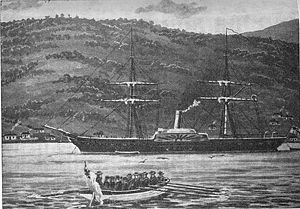HMS Growler (1841)
 Sister-ship, HMS Driver
| |
| History | |
|---|---|
| Name | HMS Growler |
| Builder | Chatham Dockyard[1] |
| Cost | £39,461[1] |
| Laid down | January 1841[1] |
| Launched | 20 July 1841[1] |
| Commissioned | 9 March 1842[1] |
| Fate | Broken up at Portsmouth by January 1854[1] |
| General characteristics [1] | |
| Class and type | Driver-class wooden paddle sloop |
| Displacement | 1,590 tons |
| Tons burthen | 1,05562⁄94 bm |
| Length | 180 ft (54.9 m) (gundeck) |
| Beam | 36 ft (11.0 m) |
| Depth of hold | 21 ft (6.4 m) |
| Installed power | 280 nhp |
| Propulsion |
|
| Sail plan | Brig-rigged |
| Complement | 149 (later 160) |
| Armament |
|
HMS Growler was a paddle-driven Driver-class sloop, built in 1841 and broken up in 1854. In 1847 she carried liberated Africans to Sierra Leone for resettlement.
Construction and commissioning
[edit]Growler was ordered under PW1840 along with other Driver-class paddle sloops,[2] laid down at Chatham Dockyard and launched on 20 July 1841.[1] She was completed at Chatham and commissioned on 9 March 1842.[1][3]
Service history
[edit]On 31 March 1842, Growler was assigned to the South East Coast of America Station to combat the slave trade.[4] She was re-assigned to the West Africa Squadron in September 1844.[3]
On 21 July 1844 Growler captured the Spanish brigantine Veterano. Then on 23 September 1844 Growler captured the Spanish slave schooner Concepcion.[Note 1]
In February 1845 she took part in Commodore William Jones's destruction of several barracoons at Dombocorro and elsewhere.[6]
The ship was involved in a scheme to relocate liberated Africans from Sierra Leone to the Caribbean, arriving in Trinidad in December 1847.[7] One hundred and fifty men, 37 women and 254 children former captives survived the journey, although 45 Africans died on the journey.[8]
Fate
[edit]Growler was broken up at Portsmouth, which was completed by 17 January 1854.[1]
Notes
[edit]Citations
[edit]- ^ a b c d e f g h i j Winfield (2004), p.160
- ^ Friedman, Norman (2012). British Cruisers of the Victorian Era. Seaforth Publishing. ISBN 9781473853126. Retrieved 9 November 2018.
- ^ a b "HMS Growler". www.pbenyon.plus.com. pbenyon.plus.com. Archived from the original on 10 August 2017. Retrieved 9 November 2018.
- ^ "HMS Growler at the William Loney R.N. website". Retrieved 26 December 2020.
- ^ "No. 20505". The London Gazette. 5 September 1845. p. 2740.
- ^ "Commodore Jones' destruction of the barracoons at Dombocorro and elsewhere in February 1845 (3: Jones' report of a subsequent conference with the Chiefs) at the Loney R.N. website". Retrieved 26 December 2020.
- ^ Adderley, Rosanne Marion (2006). "New Negroes from Africa": Slave Trade Abolition and Free African Settlement in the Nineteenth-century Caribbean. Indiana University Press. ISBN 0253347033. Retrieved 9 November 2018.
- ^ Charles Day, Williams (1852). Five Years' Residence in the West Indies Vol. 1. Colburn and co. Retrieved 9 November 2018.
References
[edit]- Winfield, R.; Lyon, D. (2004). The Sail and Steam Navy List: All the Ships of the Royal Navy 1815–1889. London: Chatham Publishing. ISBN 978-1-86176-032-6. OCLC 52620555.
